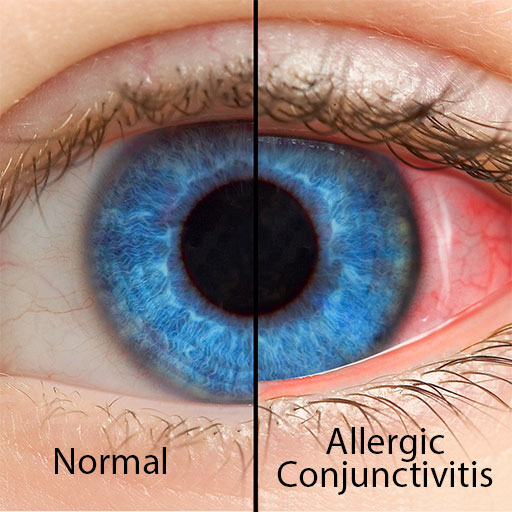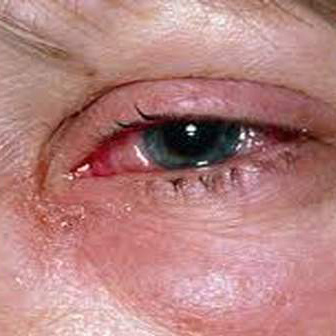Overview
Allergic conjunctivitis is an inflammation of the thin clear membrane that covers the white of the eye, and the inside layer of the eyelids. It is to an allergic reaction to a substance, most commonly grasses, dust, feathers, pollen from flowers or trees, mould, animal hair or fur, and many household detergents, and in some cases fabric softeners and perfumes or deodorants (especially the aerosol types).
The Symptoms of allergic conjunctivitis might include severe hayfever, redness, itching, and excessive tearing. Swollen Lids, burning eyes, and sensitivity to bright light are also common symptoms. Treatment is mainly avoidance of the causative substance, and treatment with antihistamines, in either tablets taken orally or eyedrops, or in severe cases both. Treatments are safe and usually effective. This condition is most common during spring, but some individuals report the symptoms all year round.
Allergic conjunctivitis is quite common. It’s your body’s reaction to substances it considers potentially harmful.
Signs and Symptoms
Allergic conjunctivitis comes in two main types:
Acute allergic conjunctivitis
This is a short-term condition that is more common during allergy season. Your eyelids suddenly swell, itch, and burn. You may also have a watery nose.
Chronic allergic conjunctivitis
A less common condition called chronic allergic conjunctivitis can occur year-round. It is a milder response to allergens like food, dust, and animal dander. Common symptoms come and go but include burning and itching of the eyes and light sensitivity.
What are the symptoms of allergic conjunctivitis?
- Both eyes are usually affected and symptoms tend to develop quickly.
- The eyes are usually itchy and gritty.
- The skin on the inside of the eyelids looks red and sore.
- The whites of the eyes look red or pink.
- A burning feeling may occur, although the eyes are not usually painful.
- The eyelids tend to swell.
- The eyes water more than usual; however, they do not become too gluey or sticky.
- Vision is not affected.
- In severe cases the conjunctiva under the upper eyelids may swell and look lumpy.
Causes and Risks
You experience allergic conjunctivitis when your body tries to defend itself against a perceived threat. It does this in reaction to things that trigger the release of histamine. Your body produces this potent chemical to fight off foreign invaders. Some of the substances that cause this reaction are:
What causes allergic conjunctivitis?
- household dust
- pollen from trees and grass
- mold spores
- animal dander
- chemical scents such as household detergents or perfume
Some people may also experience allergic conjunctivitis in reaction to certain medications or substances dropped into the eyes, such as contact lens solution or medicated eye drops.
Who is at risk for allergic conjunctivitis?
- People who have allergies are more likely to develop allergic conjunctivitis. According to the Asthma and Allergy Foundation of America, allergies affect 30 percent of adults and 40 percent of children, and often run in families.
- Allergies affect people of all ages, though they are more common in children and young adults. If you have allergies and live in locations with high pollen counts, you are more susceptible to allergic conjunctivitis.
Stats and Incidence
Allergic conjunctivitis is a key component in the spectrum of allergic diseases that is sometimes collectively referred to as rhino-conjunctivitis. Because of its high prevalence worldwide, it exacts an increasing toll in terms of patient discomfort, morbidity, and loss of productivity. Current estimates suggest that at least 20% of the overall population suffers from some form of allergic conjunctivitis, many without ever seeking treatments. In addition, a significant proportion of patients experience chronic forms of allergy that are less responsive to existing therapies. Recent approval of immunotherapy-based treatments may address this therapeutic gap.
Treatment
Home care
Treating allergic conjunctivitis at home involves a combination of prevention strategies and activities to ease your symptoms. To minimize your exposure to allergens:
- close windows when the pollen count is high
- keep your home dust-free
- use an indoor air purifier
- avoid exposure to harsh chemicals, dyes, and perfumes
To ease your symptoms, avoid rubbing your eyes. Applying a cool compress to your eyes can also help reduce inflammation and itching.
Medications
In more troublesome cases, home care may not be adequate. You will need to see a doctor who might recommend the following options:
- an oral or over-the-counter antihistamine to reduce or block histamine release
- anti-inflammatory or anti-inflammation eye drops
- eye drops to shrink congested blood vessels
- steroid eye drops


